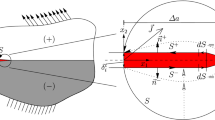Abstract
We consider the problem of the dynamic, transient propagation of a semi-infinite, mode I crack in an infinite elastic body with a nonlinear, viscoelastic cohesize zone. Our problem formulation includes boundary conditions that preclude crack face interpenetration, in contrast to the usual mode I boundary conditions that assume all unloaded crack faces are stress-free. The nonlinear viscoelastic cohesive zone behavior is motivated by dynamic fracture in brittle polymers in which crack propagation is preceeded by significant crazing in a thin region surrounding the crack tip. We present a combined analytical/numerical solution method that involves reducing the problem to a Dirichlet-to-Neumann map along the crack face plane, resulting in a differo-integral equation relating the displacement and stress along the crack faces and within the cohesive zone.
Similar content being viewed by others
References
Allen DH, Searcy RS (2001) A micromechanical model for a viscoelastic cohesive zone. Int J Frac 107: 159–176
Barenblatt GI (1962) The mathematical theory of equilibrium cracks in brittle fracture. In: Dryden HL, von Karman TH (eds) Advances in applied mechanics, vol VII. Academic Press, New York, pp 55–129
Broberg KB (1999) Cracks and fracture. Academic Press, New York
Costanzo F, Walton JR (1998) Numerical simulations of a dynamically propagating crack with a nonlinear cohesive zone. Int J Fract 91(4): 373–389
Costanzo F,Walton JR (1997) A study of dynamic crack growth in elastic materials using a cohesive zone model. Int J Eng Sci 35(12–13):1085–1114
Freund LB (1990) Dynamic fracture mechanics. Cambridge University Press, Cambridge
Herrmann JM, Walton JR (1989) On the energy release rate for dynamic transient anti-plane shear crack propagation in a general linear viscoelastic body. J Mech Phys Solids 37(5): 619–645
Herrmann JM, Walton JR (1994) The energy release rate for transient dynamic mode I crack propagation in a general linearly viscoelastic body. Quart Appl Math 52(2): 201–228
Kostrov BV (1966) Unsteady propagation of longitudinal shear cracks. Appl Math Mech (PMM) 30(6): 1042–1049
Kostrov BV, Nikitin LV (1970) Some general problems of mechanics of brittle fracture. Arch Mech Stos 22: 749–775
Leise TL, Walton JR (2001) A general method for solving dynamically accelerating multiple co-linear cracks. Int J Fract 111(1): 1–16
Leise TL, Walton JR (2001) Dynamically accelerating cracks. II. A finite length mode III crack in elastic material. Quart Appl Math 59(4): 601–614
Leise TL, Walton JR (2003) A method for solving dynamically accelerating crack problems in linear viscoelasticity. SIAM J Appl Math 61(1): 94–107
Leise TL, Walton JR (2004) An analytical and numerical study of a dynamically accelerating semi-infinite crack in a viscoelastic material. Int J Fract 127(2): 101–117
Leise TL, Walton JR, Gorb Y (2008) Reconsidering the boundary conditions for a dynamic, transient mode I crack problem. JoMMS 3(9): 1797–1807
Needleman A (1997) Numerical modeling of crack growth under dynamic loading conditions. Comput Mech 19(6): 463–469
Saraikin VA, Slepyan LI (1979) Plane problem of the dynamics of a crack in an elastic solid. Mech Solids 14(4): 46–62
Slepyan LI (2002) Models and phenomena in fracture mechanics, foundations of engineering mechanics. Springer-Verlag, Berlin
Walton JR (1987) The dynamic, energy release rate for a steadily propagating anti-plane shear crack in a linearly viscoelastic body. J Appl Mech 54(3): 635–641
Walton JR, Herrmann JM (1992) A new method for solving dynamically accelerating crack problems. I. The case of a semi-infinite mode iii crack in elastic material revisited. Quart Appl Math 50(2): 373–387
Walton JR (1990) The dynamic energy release rate for a steadily propagating mode I crack in an infinity, linearly viscoelastic body. J Appl Mech 112: 343–353
Walton JR (1996) On a dynamically accelerating Dugdale-zone in elastic and viscoelastic material. J Mech Phys Solids 44(8): 1353–1370
Author information
Authors and Affiliations
Corresponding author
Additional information
to appear Int. J. Frac., special issue devoted to the IUTAM Symposium: Dynamic Fracture and Fragmentation, 8–12 March 2009.
This work was supported in part by the Army Research Laboratory under contract number W911NF-04-2-00-11 and in part by award number KUS-C1-016-04 made by King Abdullah University of Science and Technology (KAUST).
Rights and permissions
About this article
Cite this article
Leise, T.L., Walton, J.R. & Gorb, Y. A boundary integral method for a dynamic, transient mode I crack problem with viscoelastic cohesive zone. Int J Fract 162, 69–76 (2010). https://doi.org/10.1007/s10704-009-9385-9
Received:
Accepted:
Published:
Issue Date:
DOI: https://doi.org/10.1007/s10704-009-9385-9




